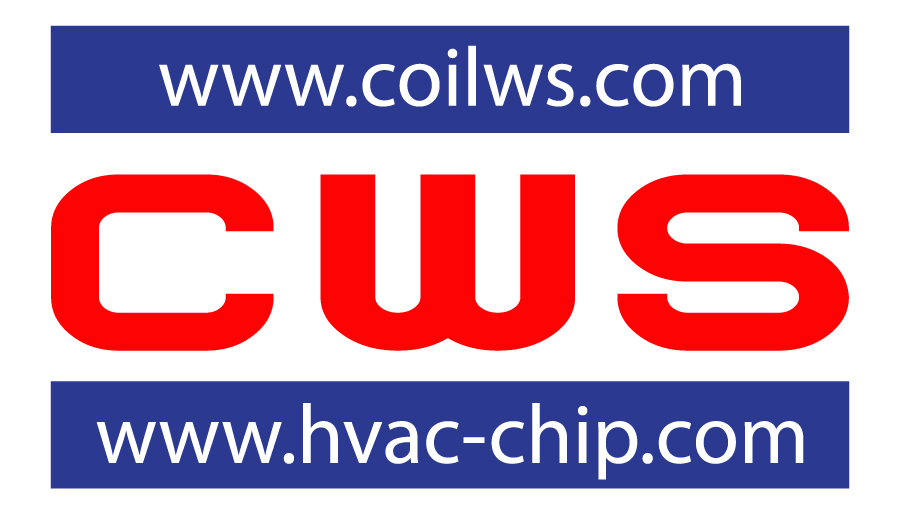 ---- July 26th 2024 ---- |



www.ccr.gov CAGE Code: 5DME2 ITAR Registration Code: M28889 |
Call: 1 (800) 377-3244 Monday to Friday 8 A.M. - 5 P.M. (Pacific Time) E-mail questions and requirements to: sales@coilws.com  *Please Note: Items without price are listed for CWS' capability purposes. |
|
Application Notes: How To Select And Use Ferrite / NanocrystalliINTRODUCTION:COMMON MODE CHOKES. Almost all electronics circuits require the use of COMMON MODE CHOKES to filter out the conducted switching and Radio Frequency noise coming from the power sources such as Switching Mode Power Supplies (SMPS) or other line power outlets. These high frequency noises from SMPS can affect the performance of other electronic devices connected to the same power source, causing potential failures. The common mode choke, as the name suggests, is used to filter out electronic noise that are common to both the power ("live") and the return line. In other words, the common mode choke is used to filter out the electronic noises that are coupled to both the power and the return lines. The engineering community has established limits to these electronics noise with standards such as EN 55011. COMMON MODE CHOKE is typically used with capacitors and differential mode inductors to form a complete filter in an electronics circuits. Figure 1 shows a typical COMMON MODE CHOKE connection. 
Figure 1. Typically, COMMON MODE CHOKE is wound on toroidal core, gapless H core or EE core. The most common material used is high permeability manganese zinc ferrites for low cost applications. In high end applications, Co-based amorphous, Fe-based amorphous and Fe-based Nanocrystalline cores materials are used. Common trade names for Amorphous and Nanocrystalline are METGLASS, FINEMET, HITPERM, VITROPERM, NANOPERM, etc. Please note that CWS is not affiliated with any of these companies. COMMON MODE CHOKE is wound with 2 identical windings, where the current in each winding flows in the opposite direction to each other. For example, the current from positive terminal of the power source will flow into the COMMON MODE CHOKE’s first winding and the return current will flow into the COMMON MODE CHOKE’s second winding before it gets to the negative terminal of the power source. The live and return currents are of same magnitude since they are from the same power source. But, the direction of the magnetic flux lines created by the current flowing into the first winding is opposite to the flux lines created by the return current into the second windings. These 2 magnetic fluxes cancel out each other creating a theoretical net flux of zero. But in real life, there is stray magnetic flux which will minimally attenuate the main currents. Since the net magnetic fluxes due to the main current flows are zero, the cores will not go into magnetic saturation in a COMMON MODE CHOKE design. Therefore, COMMON MODE CHOKE’s core will not saturate due to the amplitude of the main currents. For example, a magnetic core that usually saturates at 5 Amps in a differential mode application will not saturate even at 100 Amps in a common mode application provided the 2 currents flowing in and out of the COMMON MODE CHOKE is of equal value or from the same source. The current rating of COMMON MODE CHOKE is determined by the resistance of the windings which causes temperature rise. However, the high frequency electronic noise currents which are of much lower amplitude and riding on the main positive and return line will encounter high impedance from the COMMON MODE CHOKE and will be severely attenuated, and therefore filters out. Design of Common Mode Choke: The core selected must provide the highest impedance over the range of the noise frequencies to be suppressed. For noise generated from SMPS, the frequency range is typically 20 KHz to 300 KHz. But with harmonics, this noise frequency could be up to 10 Mhz. For inverters, the noise frequency is from 10 KHz to 30 Mhz. As can be seen from Coil Winding Specialist Inc ("CWS") Common Mode Chokes’ data sheets, the Impedance versus Frequency graphs shows the highest impedance are from 1 Mhz to 10 MHz range. Comparing Magnetics core materials used in Common Mode Chokes: In recent years, the use of amorphous and nanocrystalline cores for COMMON MODE CHOKE has become more prevalent due to the readily availability of the material. The Nanocrystalline core has the following advantages: a) Very high permeability, typically from 20,000 to 200,000 ui which reduces the size of the component. Coil Winding Specialist Inc. (“CWS”) has recently introduced a line of COMMON MODE CHOKE based on amorphous and nanocrystalline cores at a reasonable cost and with short lead time, in addition to its regular suites of ferrite based COMMON MODE CHOKE. CWS is able to procure amorphous and nanocrystalline cores at a reasonable cost by partnering with manufacturers, and by increasing its usage volume and is stocking many sizes of the cores at its factory to reduce the lead time. Amorphous and nanocrystalline cores are made of thin ribbon film of glassy material coiled together into a core. The material is fragile and breaks easily like a glass. All amorphous and nanocrystalline based COMMON MODE CHOKE from CWS is wound on these ribbon cores that are potted inside a high temperature plastic case that are encapsulated and vibration tested and drop tested. Other materials used in COMMON MODE CHOKE are Co based amorphous. The Co based amorphous has permeability of over 100,000 ui, saturation flux of 0.6 Tesla, Curie temperature of 210 deg C and working temperature of 90 deg C. But the lower cost Fe based amorphous has permeability of 30,000 ui, saturation flux of 1.7 Tesla, curie temperature of 600 deg C and working temperature of 100 deg C. CWS does not offer any COMMON MODE CHOKE manufactured using the Co based amorphous materials at this time due to cost and availability. INSERTION LOSS AND IMPEDANCE OF COMMON MODE CHOKE. Where V1 is the voltage between the voltage source and the load before the insertion of the COMMON MODE CHOKE, and V2 is the voltage after the insertion of COMMON MODE CHOKE. For frequency below 2 MHz, the insertion loss or |Z| is due to the impedance of the COMMON MODE CHOKE. For frequency above 2 MHz, the insertion loss or |Z| begins to drop due to the inter-winding capacitance. Reducing the number of turns or space out the windings in a COMMON MODE CHOKE design to minimize the inter-winding capacitance can extend filtering range of the COMMON MODE CHOKE. The self resonance frequency (SRF) of a common mode choke shows where the peak insertion loss occurs.The Commom Mode Choke to select should be those where the SRF is close to the frequency where the highest noise amplitude occurs. The datasheet from CWS shows the |Z| versus frequency for all the nanocrystalline line of COMMON MODE CHOKE as it is easier to measure and characterized them during production. COMPARISON BETWEEN NANORYSTALLINE COMMON MODE CHOKE AND FERRITE COMMON MODE CHOKE 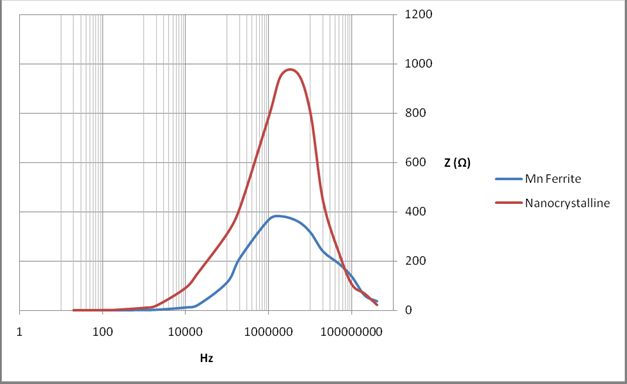 As can be seen from the above graphs, the Nanocrystalline Common Mode choke provides damping of the noise frequency over a wider frequency range. The impedance or the insertion loss is over twice that of the ferrite core common mode choke. Nanocrystalline core is particularly suitable for use in 3 phase common mode chokes. CWS now offers 3 phase common mode chokes wound on 3 inch nanocrystalline cores that meets the safety requirements for spacing. Based on the data obtained by CWS from our laboratory, we have found that the size reduction of the common mode choke using the nanocrystalline core can be from 50% to 75% as compared to that of ferrite core based common mode choke. Types of Common Mode Chokes from Coil Windings Specialist Inc: 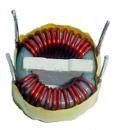 CM, PM and C Series of Ferrite Toroid Common Mode Choke. 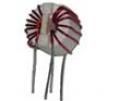 HL, S and LF Series of Ferrite Toroid Common Mode Choke in nylon case 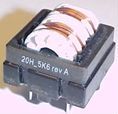 20, 24, 28 and 35 Series Gear Wound Common Mode Choke 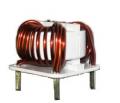 Case Type Amorphous and Nanocrystalline Common Mode Chokes 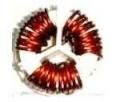 3 Phase Nanocrystalline Common Mode Choke |
Disclaimer: Coil Winding Specialist, Inc., its affiliates, agents, and employees acting on behalf of Coil Winding Specialist, Inc. (collectively, CWS) disclaim any and all liability for any errors, inaccuracies or incompleteness contained herein or in any other disclosure relating to any product. CWS reserves the right at any time and from time to time to make changes to design, technical specification, or construction of any product listed on this website without notice. CWS also reserves the right to discontinue or limit sale of any product or service available throughout this website on temporary or permanently basis without notice. CWS highly recommends customers not to use its products offered on this website for inappropriate use and applications. Products should be tested for its suitability by prospective customers in all possible applications and conditions. Customers using or selling CWS products for use in other than recommended applications do so entirely at their own risk and agree to fully indemnify CWS from any damages arising or resulting from such use or sale.
WARNING: This product can expose you to chemicals which is [are] known to the State of California to cause cancer and birth defects or other reproductive harm. For more information go towww.P65Warnings.ca.gov.
![]()
![]()
![]()
![]()

Any Comments, Suggestions or Questions? Contact us!
Email: sales@coilws.com
CWS
353 West Grove Ave. Orange, California 92865
Call us Toll Free: 1-800-679-3184 or 1 (800) 377-3244
Tel: (714) 279-9010,
Fax: (714) 279-9482
Copyright 2008, Coil Winding Specialist, Inc
Updated July, 2013
CAGE Code: 5DME2(Registered with www.ccr.gov)
